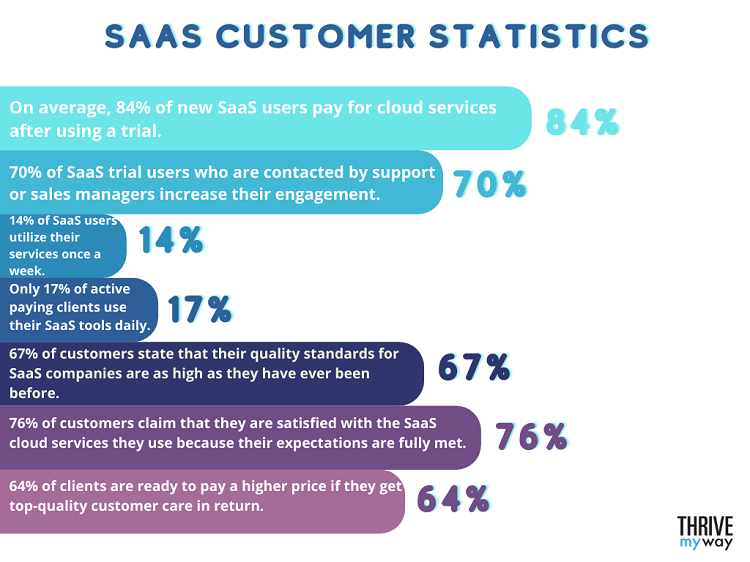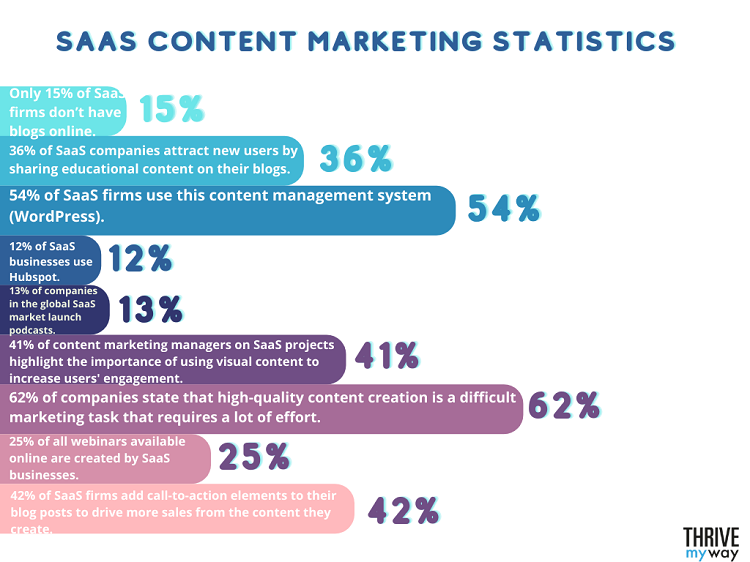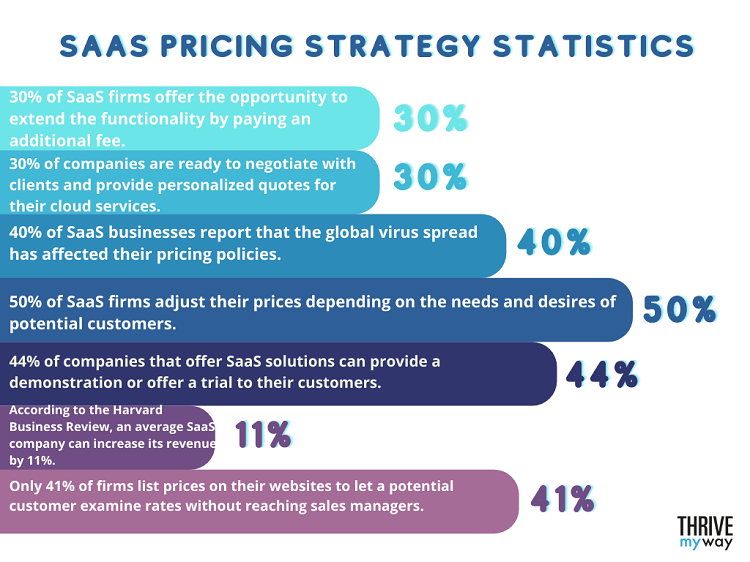Indeed, SaaS (Software as a Service) is a new trend that has and continues to grow quickly. It is also known as subscription-based or web-hosted solutions offered by software companies.
Let’s explore the SaaS stats below to discover how fast it grows.
General SaaS Stats and Trends for 2023
- The SaaS market has tripled its size in the last five years.
- The global SaaS industry revenue is expected to reach $171 billion last 2022.
- 38% of companies that offer SaaS solutions don’t rely on a monthly subscription to generate their revenue. Instead, they change users according to their usage.
- Salesforce was the leading SaaS organization in 2019, and it remains so today. In addition, Salesforce is expected to grow by 50% over the next four years.
- Microsoft is the #1 SaaS provider on the market. Its share is 17%.
- The total market value of the top ten SaaS companies is over $1 trillion. The market capitalization of the largest one, Salesforce, is $307 billion.
- The US is the leading country in SaaS industry development.
- More than 10,000 private SaaS companies are founded.
SaaS Adoption Stats 2023
- 38% of companies state that 100% of their operational processes are running on SaaS platforms.
- On average, the SaaS industry experiences an 18% annual growth.
- 99% of companies on the market use at least one SaaS solution to run their businesses.
- 78% of small enterprises invest in at least one SaaS tool.
- 93% of CIOs (chief information officers) state that SaaS adoption can help their businesses grow and achieve their goals.
- 92% of businesses are focused on cloud adoption to enhance their business processes.
- Roughly 50% of government organizations in the US use a public cloud.
- 38% of companies switch to SaaS and a public cloud to keep their data safe from possible disasters that may damage local servers.
- 37% of enterprises use cloud services due to the great level of flexibility offered.
- Enterprises typically spend 15% of their budgets on SaaS tools.
- On average, a company uses 80 SaaS applications to establish all working processes. They are helpful for marketing purposes and effective client acquisition.
SaaS Churn Statistics 2023
- On average, the churn rate of a SaaS firm is 6-10%. In a nutshell, the churn rate defines the share of customers who stopped using a product during a particular period.
- A third of SaaS companies report that their churn rate has increased during the last year.
- A SaaS startup may have up to a 60% revenue churn rate. The revenue churn rate is the percentage of revenue lost from returning customers or subscription renewals who choose not to renew.
- 42% of customers report that the quality of support affected their decision to stop using a SaaS application.
- 69% of companies take the number of customers into account when calculating their churn rate.
SaaS Purchase and Usage Statistics

- On average, a company spends $2,623 per employee per year to cover SaaS subscription expenses.
- The most recent SaaS statistics say that companies spend 25% of their budget on a public cloud and other SaaS solutions, on average.
- By moving to a public cloud, the IT maintenance cost has decreased by 16.1%, on average.
- 83% of enterprises report that their employees store clients’ sensitive data on third-party cloud services without permission.
- 48% of employees use at least one SaaS app that their IT departments do not distribute to maintain business processes. For example, they may use the GoToMeeting SaaS software for running video meetings with people instead of utilizing Google Meet under a corporate account.
- 26% of business in the EU uses a public cloud.
- On average, companies spend 15% more than they could on cloud SaaS services because of using apps they don’t need.
- Every tenth SaaS product that users pay for remains inactive for the first 90 days.
- 61% of businesses have more than 100 SaaS apps used by their employees.
- 77% of managers want to get a solution that helps measure the effectiveness of their subscription-based cloud services.
SaaS Customer Statistics

- Flexibility and agility are the main reasons why each new customer decides to switch to cloud-based solutions.
- On average, 84% of new SaaS users pay for cloud services after using a trial.
- 70% of SaaS trial users who are contacted by support or sales managers increase their engagement. Therefore, customer care is vital to increase revenue from a SaaS company.
- Half of the customers who pay for their subscription-based cloud services log in to their accounts less than once a month.
- 14% of SaaS users utilize their services once a week.
- Only 17% of active paying clients use their SaaS tools daily.
- It’s 4 times cheaper for SaaS companies to upsell an existing client than to invest in new lead generation.
- 67% of customers state that their quality standards for SaaS companies are as high as they have ever been before. Moreover, the demand for top-quality service keeps growing at a high pace.
- 76% of customers claim that they are satisfied with the SaaS cloud services they use because their expectations are fully met.
- 64% of clients are ready to pay a higher price if they get top-quality customer care in return.
Regional SaaS Statistics
- The United States is home to the majority of SaaS companies. There are more than 15,000 SaaS firms in the US.
- The US, UK, Canada, Germany, and France are the top five countries that develop the SaaS industry quickly. Every country has from one to two thousand SaaS companies.
- India is the leading country in the SaaS industry in Asia.
- Brazil is a top county in Latin America by the number of SaaS startups.
- The SaaS niche in the UK, European Union, and China is expected to double in size in five years.
- SaaS brands are the most popular type of new business launched in South America
SaaS Category Statistics
- The market revenue generated by Zoom has increased five times during the last five years.
- According to recent SaaS statistics, Cisco experienced only a 1% growth in the SaaS market last year.
- Visma is a leading vertical SaaS company in the CRM market. It makes 3 times larger revenue than other successful companies. It reached $2.2 billion in revenue in 2021.
- The revenue of the Zoom company reached $1 billion in the second quarter of 2021.
- The number of Zoom downloads has reached 485 million, making it the most popular video conferencing software on the Internet.
- SaaS statistics say that 44% of cloud security privileges are configured incorrectly.
SaaS Content Marketing Statistics 2023

- Only 15% of SaaS firms don’t have blogs online.
- 36% of SaaS companies attract new users by sharing educational content on their blogs. Top-quality content marketing can help increase a SaaS company’s revenue.
- WordPress is the most popular CMS (content management system) used by SaaS companies to share content online. 54% of SaaS firms use this content management system.
- 12% of SaaS businesses use Hubspot as a platform to spread their content on the Internet.
- 13% of companies in the global SaaS market launch podcasts for effective customer acquisition.
- 41% of content marketing managers on SaaS projects highlight the importance of using visual content to increase users’ engagement.
- 62% of companies state that high-quality content creation is a difficult marketing task that requires a lot of effort.
- 25% of all webinars available online are created by SaaS businesses.
- 42% of SaaS firms add call-to-action elements to their blog posts to drive more sales from the content they create.
SaaS Email Marketing Statistics 2023
- The majority of emails sent by SaaS organizations are automatic. They keep users updated about new changes, share announcements, etc.
- Welcome emails sent by marketers get 5 times more open than other types of messages.
- SaaS startups state that email marketing is the most effective way to attract new leads and maintain relationships with existing customers.
- Emails sent by robots help SaaS firms generate 320% more revenue than emails composed by marketing managers.
- Only one in five customers opened emails sent. The click-through rate is 2.5%.
- 95% of businesses primarily use emails to communicate with SaaS companies.
SaaS Pricing Strategy Statistics 2023

- A third of SaaS companies offer their clients the option to purchase additional features to increase their revenues.
- 30% of SaaS firms offer the opportunity to extend the functionality by paying an additional fee.
- 30% of companies are ready to negotiate with clients and provide personalized quotes for their cloud services.
- 40% of SaaS businesses report that the global virus spread has affected their pricing policies. A lot of companies had to lower their prices or extend their packages to attract more clients who were looking for SaaS software when they switched online because of the outbreak in 2020.
- 50% of SaaS firms adjust their prices depending on the needs and desires of potential customers.
- 44% of companies that offer SaaS solutions can provide a demonstration or offer a trial to their customers.
- According to the Harvard Business Review, an average SaaS company can increase its revenue by 11% by increasing its rates by 1%.
- Only 41% of firms list prices on their websites to let a potential customer examine rates without reaching sales managers.
SaaS Spending Statistics 2023
- Spending on cloud services by the US government increases by 17% every year.
- Spending on cloud SaaS solutions for analytics by businesses has increased 23% in the last five years.
- 20% of companies state that their SaaS spending was not affected by the pandemic.
- 30.4% of enterprises reported increasing their spending on SaaS solutions because they needed to establish remote working processes due to the pandemic.
- 47% of firms expect their bills for cloud maintenance to increase in the next year.
- 94% of IT executives are sure that their decisions regarding SaaS could be managed more effectively.
- On average, a mid-size company spends $343,000 per year on SaaS tools.
- 52% of SaaS businesses increased their spending on customer retention in the last year.
SaaS Sales and Marketing Statistics 2023
- 48% of companies make one-year contracts when purchasing a SaaS solution.
- 13% of enterprises make payments every month to access a SaaS management platform.
- In most cases, a trial period for SaaS companies lasts for 30 days.
- In the first five years, an average SaaS business invests 80% of its revenue in marketing and customer acquisition.
- Free trials that don’t need users to share their credit card credentials increase the likelihood that a customer will end up purchasing cloud computing tools by double.
SaaS Growth Statistics
- The adoption of SaaS solutions in the healthcare industry is growing by 20% every year.
- German SaaS growth is the highest in the European Union.
- Companies that invest in the SaaS sector report that they can implement innovations 30% faster with the help of cloud-based solutions.
- The global SaaS market is growing 6.5x faster than the rest of the global economy.
- 64% of companies want to allow their employees to keep working remotely after the pandemic, so the demand for SaaS solutions will continue to rise.
- The niche focused on developing SaaS marketing automatization tools is expected to attract $25 billion of investments by 2023.
- By 2026, half of all the enterprises that use SaaS solutions want them to be centralized to make SaaS management more efficient.
You might be interested to check those related posts as well:
- Hunter.io Review: Is it the best cold outreach solution in 2023?
- The Truth About User Onboarding – Why It’s Important and What To Do About It
- Semrush Review [2023]- All-in-one SEO and Marketing Tool
FAQ
What is a good SaaS growth rate?
It depends on the size of the company. On average, a small SaaS company grows by 50% per year or more. The fastest-growing SaaS companies add more than 100% to their revenue year-to-year. However, large enterprises in the SaaS industry only increase their revenues by 25%-45% per year.
How many SaaS apps do companies use?
According to the latest SaaS statistics, companies’ number of SaaS apps has increased ten times in the last five years. These days, enterprises use 110 SaaS applications, on average. Nevertheless, employees tend to use different apps to enhance their working process without getting permission from their IT departments.
What is the cold-calling success rate?
Unfortunately, cold calling needs people to invest a large amount of time in user acquisition due to a low success rate. According to recent research, skilled managers can attract only one customer by making 50 calls, which is only a 2% success rate. Novices have less than a 1% rate of successful cold calls.
Conclusion
According to SaaS statistics, cloud-based service is a new trend that brings a lot of advantages to both end-users and businesses.
Moreover, SaaS companies have experienced fast-paced growth that was stimulated by the pandemic. Additionally, most SaaS firms are expected to keep growing quickly in the future.



